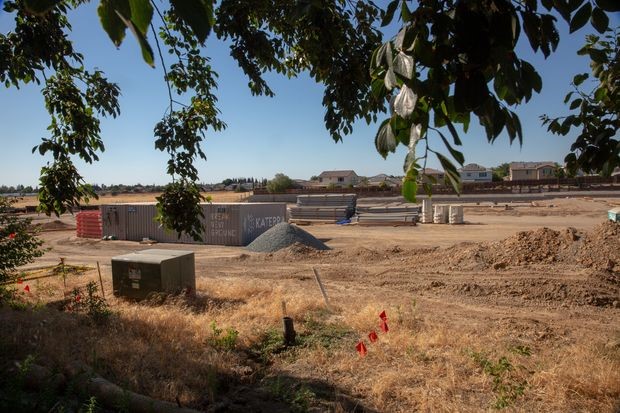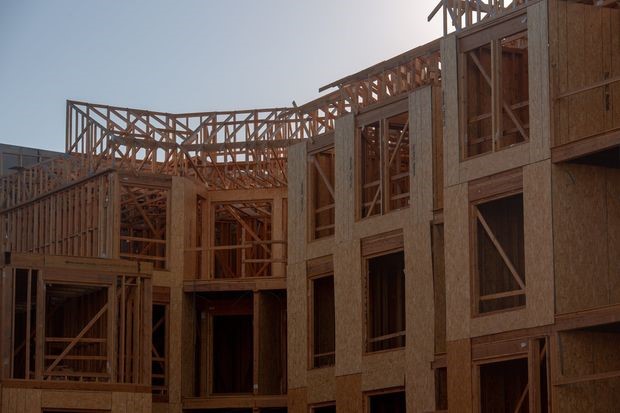Katerra Employees Weigh in on Why It Failed
Originally Published by: The Wall Street Journal — June 29, 2021
SBCA appreciates your input; please email us if you have any comments or corrections to this article.
Venture-backed startup Katerra Inc. aimed to revolutionize the construction business by mastering every element of the trade at once. Instead, its June bankruptcy filing made clear just how difficult it is for Silicon Valley to disrupt this complex industry.
The firm’s downfall wiped out nearly $3 billion of investor money, making it one of the best-funded U.S. startups ever to go bankrupt. Katerra thought it could save time and money by bringing every step of the construction process in-house—from manufacturing windows to factory-built walls to making its own lightbulbs.

Katerra's Valpico Glenbriar Apartments construction site, pictured on June 26, in Tracy, Calif., sits unfinished after the company declared bankruptcy.
It sold the idea to a deep-pocketed roster of financial backers, including SoftBank Group Corp. , Soros Fund Management LLC and the Canada Pension Plan Investment Board. At its peak, the company was valued at nearly $6 billion.
But Katerra never managed to do very well at all the aspects of construction it hoped to master, former employees say, leaving some of them exasperated at its recent demise.
“You guys had the golden goose, you had all that money from SoftBank and at the end of the day it was all pissed away,” said Chris Severson, a former construction-cost estimator at Katerra.
Katerra’s failure is the latest sign that the hypergrowth strategy employed by social media and software companies faces challenges in complicated, slower-moving industries like real estate.
Its bankruptcy also highlights the difficulty of modernizing construction, which accounts for around 4% of U.S. gross domestic product but still operates largely the way it did 100 years ago.
The company is in the process of crafting a restructuring through a chapter 11 bankruptcy process—one that involves selling some assets and keeping its international operations, a Katerra spokesman said.
The Menlo Park, Calif.-based company was co-founded in 2015 by a group of entrepreneurs including Chief Executive Michael Marks, the former CEO of electronics manufacturer Flextronics International Ltd.
Katerra’s strategy was to bring the electronics industry’s end-to-end manufacturing process to the construction business. The firm would buy materials and fixtures like sinks and faucets in bulk, skipping the middlemen and selling them directly to general contractors. When the company found general contractors were reluctant to use their products, Katerra took on that role, too.
Properties would be built with assembly-line-made parts in its own factories and shipped to sites managed by its in-house construction business. Katerra would then turn them into apartments, hotels or offices designed by its architects, all with the help of its in-house software.
This would streamline the process and enable an apartment building to be built in as few as 30 days, slicing off many months that the process would take through traditional construction.
Katerra managed to succeed with some of this top-to-bottom process, but few developers were interested in everything Katerra offered.
Still, as Katerra’s business model became more complex, it found a new backer in SoftBank. With the help of the Japanese conglomerate’s nearly $2 billion investment, Katerra bought general contractors across the U.S. and a building-parts manufacturer in India. It was further aided by $440 million in debt from Greensill Capital, a SoftBank-backed lender that tumbled into insolvency in March. Eyeing international expansion, Katerra signed a contract to build thousands of homes in Saudi Arabia.
“Everyone’s so excited about the mission that everybody just says yes to everything,” recalled Erica Storck, one of the company’s first employees. ‘It gets out of control.”
In its race to boost revenue, Katerra agreed to build properties before it had figured out how to mass-produce building parts and get them to its projects cheaply and quickly enough to make the model work, say former employees, customers and investors. Architects designed buildings with parts from Katerra’s factories, only to learn that the parts wouldn’t be ready. Losses on projects piled up.
The company often signed contracts with prices based on rosy projections and then turned to its in-house team of estimators to figure out how much it would actually cost. Often there was a gap of millions of dollars, said Mr. Severson, the former Katerra estimator.
“We just beat our heads against the wall going: ‘No you can’t, it’s not possible,” Mr. Severson recalled. In one case, the company briefly considered leaving air-conditioning units out of a California student-housing development to make the numbers work, he said.

Katerra's Legacy at Livermore construction site, pictured on June 26, in downtown Livermore, Calif. The site now sits unfinished after the company declared bankruptcy in June.
When architects and engineers raised concerns, Katerra executives would at times hold up an iPhone, telling the skeptical workers that if it could be done for phones, it could be done for apartments, a former employee said.
Rather than mass-produce a single type of building, Katerra built offices, hotels, single-family homes and apartment buildings of varying heights. That made it much harder to mass-produce prefabricated parts in factories and reduce costs because a wall panel designed for a three-story apartment building didn’t work for a 10-story building, former employees said.
The contractors it acquired also often balked at buying parts from Katerra, preferring their old subcontractors and suppliers, these people said.
By early 2020, the company was in danger of running out of money. Mr. Marks’s solution was to go even bigger. To realize his seamless vision, he believed Katerra needed to also be a developer that would own stakes in the real-estate projects it built and get a cut of their profits. That, he said, was where the real money was, former employees recalled.
The company’s board, though, ousted him early last year. His successor, the former oil-field-services executive Paal Kibsgaard, cut costs in part by shrinking the company’s research and design and manufacturing divisions. The cuts came too late, and Katerra filed for bankruptcy protection on June 6.
Former employees said they still believe in the idea of a vertically integrated, automated construction company. Multiple former executives said they believe cost overruns on early projects obscured more recent progress elsewhere in the business, and Katerra could have been profitable if it pivoted to more development and stayed focused on growth.
Still, many in the industry think a more focused approach is better.
“The problem’s not money,” said Gerry McCaughey, whose Entekra LLC makes factory-built wood frames for houses. “They were trying to go end-to-end on everything—and that’s what failed.”


